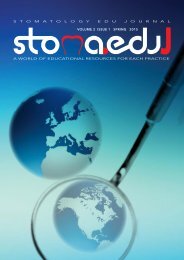Stomatology Edu Journal 1/2014
You also want an ePaper? Increase the reach of your titles
YUMPU automatically turns print PDFs into web optimized ePapers that Google loves.
overdenture<br />
FUNCTIONAL EVALUATION OF<br />
IMPLANT SUPPORTED PROSTHESES<br />
https://doi.org/10.25241/stomaeduj.<strong>2014</strong>.1(1).art.7<br />
Cite this article:<br />
Tartaglia GM, Sforza C.<br />
Functional evaluation<br />
of implant supported<br />
prostheses. Stoma <strong>Edu</strong> J.<br />
<strong>2014</strong>; 1(1):41-47.<br />
Abstract<br />
Purpose: Surface electromyography is currently considered a useful tool for dentistry allowing<br />
the validation of conventional morphological evaluations with an accurate and objective<br />
quantification of the functional activity. An evaluation of full mouth resin prostheses on implants<br />
was performed including both a morphological evaluation of occlusion and a measurement of<br />
the actual impact of morphology on stomatognathic function.<br />
Methodology: The measurement was performed using masticatory muscle electromyographic<br />
recordings with ad-hoc software algorithms. In the present study, five patients with full mouth<br />
resin prostheses on implants have been evaluated at the beginning of their prosthetic<br />
reconstructions and after one year using surface electromyography. To verify the static<br />
neuromuscular equilibrium of occlusion, functional evaluation of the left and right masseter and<br />
temporalis anterior muscles was performed in all patients, and a set of indices was computed:<br />
the Percentage Overlapping Coefficient – POC (an index of the symmetric distribution of the<br />
muscular activity determined by the occlusion), the Torque Coefficient - TC (an index of the<br />
possible presence of a mandibular torque) and the antero-posterior coefficient (an index of the<br />
possible relative position of the occlusal center of gravity).<br />
Results: One year after surgery during the maximum voluntary clench, all patients had<br />
symmetric standardized potentials (POC values between 80% and 100%, and TC values larger<br />
than 90%).<br />
Conclusions: Surface electromyography indices were well super imposable to the values found<br />
in healthy subjects with natural and normal occlusion, thus indicating that, at short time follow<br />
up, a functionally stable occlusion could protect from resin prosthodontic fractures.<br />
Keywords: electromyography, prostheses, implants<br />
Gianluca Martino<br />
Tartaglia a ,<br />
Chiarella Sforza b<br />
LAFAS, Laboratorio di Anatomia<br />
Funzionale dell'Apparato<br />
Stomatognatico, Dipartimento<br />
Scienze Biomediche per la Salute,<br />
Facoltà di Medicina e Chirurgia,<br />
Università degli Studi di Milano,<br />
Milano, Italy<br />
a. DDS, PhD, Associate Professor<br />
b. MD, PhD, Professor<br />
Introduction<br />
Today, several clinical tools can support the daily clinical practice in dentistry with a<br />
quantitative support helpful for diagnosis, measuring the effects of therapy, and timely<br />
detection of the possible failures or relapses.<br />
Surface electromyography (EMG) is able to support conventional morphological<br />
evaluations with an accurate and objective quantification of functional activity and it is<br />
currently considered a useful tool for dentistry. Engineers, biological and dental researchers<br />
have developed useful EMG protocols that couple the scientific accuracy, indispensable in<br />
all instrumental evaluations (1), with the simplicity necessary for daily use in dental practice.<br />
Therefore, starting from the multiple information collected during the computerized<br />
analysis, a selection of simple and well reproducible indices (with a clear biological<br />
and clinical significance, and easily comprehensible), should be made. Moreover, the<br />
quantitative data should be coupled with a graphic support allowing an easier and more<br />
efficient communication between the clinician and the patient. In other words, diagnosis<br />
should be supported “at a glance” (1,3).<br />
A correct evaluation of prostheses should include both the morphological evaluation<br />
of occlusion, and the measurement of the impact of customized morphology of dental<br />
contacts on stomatognathic function in each single patient. Among the various clinical<br />
protocols currently used in prosthodontics, the immediate loading of implants with full<br />
mouth resin restorations has been proposed as simpler, less time and money consuming<br />
than delayed loading of implants.<br />
In our prosthodontic practice, we tried to develop a practical application of wellstandardized<br />
sEMG protocols developed in research laboratories (1-7) to help clinical<br />
work. A quantitative clinical tool may reduce complications in implant supported, all-<br />
Received: 09 November 2013<br />
Accepted: 16 December <strong>2014</strong><br />
* Corresponding<br />
Author:<br />
Professor Chiarella Sforza,<br />
MD, PhD<br />
Dipartimento Scienze<br />
Biomediche per la Salute,<br />
Facoltà di Medicina e Chirurgia,<br />
Università degli Studi di Milano,<br />
Milano, Italy.<br />
via Luigi Mangiagalli 31,<br />
I-20133 Milano, Italy.<br />
Tel. +390250315385,<br />
Fax +390250315387<br />
e-mail: chiarella.sforza@unimi.it<br />
41




